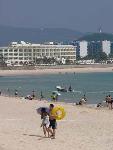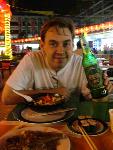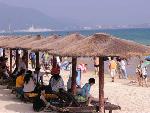- Getting around Lijiang. Dont stay in the Old Towns more than 2 days, there is nothing to do. KRISS Oct 9, 2013 05:46
- 2013 Beijing Temple Fair BENNYLAU Feb 26, 2013 03:29
- Malaysian traveling from KUL - LAX vis Shanghai PVG ZATI_DY Jan 3, 2013 20:15
One Night in Dadonghai
- Views: 6788
- |Vote: 0 0
- |Add to Favorites
- |Recommend to Friends
Onwards to Sanya
Tropical islands are supposed to be intensely relaxing places, but after a couple of days exploring the fast, exciting city of Haikou, I was exhausted and slept late. It was a blow to my schedule – I was hoping to get an early bus to Sanya, China's ultimate tropical destination, but when my morning alarm sounded, it seemed far more sensible to aggressively switch it off and turn over on my soft pillow for another couple of hours' snooze.
And why not? Hainan's lifestyle is defined by not being bound to the conventional rules of punctuality and timetable – that is, unless you're on a breakneck organized tour of the island. I was not, and checked out of my hotel at midday, not actually very long after I'd gotten out of bed. That's the island life.
I'd spotted a long-distance bus terminal the day previous when sightseeing, but after storing my bags in the New Hongkong Hotel (a service this excellent hotel offers for free) and taking a long, bumpy bus ride out there, I was politely informed I'd come to the wrong place. I was at the West Station; the busses to Sanya now leave from the South Station, and so I sadly boarded another public line to get down there. By the time I had purchased my ticket – much more expensive than I'd expected, at RMB78 – it was already 2.:20pm and I wasn't expecting to arrive in Sanya until six.
The air-conditioned, comfortable service to Sanya wound its way out of the enormous Haikou city and hurtled south into the Hainan farmlands. I was most fascinated, as I watched from the windows, to see the local farmers bend over the green rice paddies wearing their conical bamboo hats, the exact image of their mainland counterparts in the lush provinces of Central China, but against the unlikely backdrop of swaying coconut trees.
We continued through the Hainanese heartland, passing through mountainous vistas where dwell communities of some of China's most remote ethnic groups, many of whom have been living here for centuries, maintaining their own way of life in the face of the encroaching modern world. Hainan's central highlands are rugged and densely forested – making for some immensely rewarding travel destinations.
But I was not headed that way on this journey, but instead for the bright lights of paradisiacal Sanya, and as the modern buildings began to congest into inner-city streets and prime retail boulevards, I was already looking forward to making my way to the location where I would be staying during my time in Sanya – the tiny, highly developed beach resort of Dadonghai.
Dadonghai
Within moments of arriving in Sanya's Dadonghai, I knew I was in a place frequented by great numbers of tourists. Not only were there numerous foreign faces conspicuously walking around the streets, but signs everywhere in foreign languages, principally Russian, were hung above store fronts, many of which sold swimming gear, exotic and expensive fruits, and racks of racks of Hawaiian shirts. The amount of people actually wearing the shirts was surprising – not only the Europeans but Chinese as well, mostly clad not only in the loud, tropical print shirts that you do actually see in the Hawaiian Islands, but pullstring shorts as well, so that everyone seemed to be wandering the streets in loud, rainbow coloured pyjamas.
I was once again making the mistake of following the directions of a guide book, trying to find a highly recommended hotel. The hotel had apparently long gone, and I instead tried another on impulse – the scruffy looking Chuanya Hotel on Haiyun Road. Despite the initial impressions I had, I was most delighted to discover that the hotel was more than acceptable, with double rooms complete with private bathrooms for just RMB60 – a steal in expensive Sanya. I quickly settled in and got ready to go outside.
Merchants were everywhere on the streets around Dadonghai, carrying their wares around with them in bags, hoping to peddle cheap souvenirs to tourists. I saw elderly Russian women haggle over strings of pearls and jade amulets – a pair of American backpackers were getting angry with an ethnic minority woman selling sugarcane from two piled-up saucers suspended from a pole she had balanced on her shoulder.
I took a side route in the general direction of the beach and within a few minutes could hear the sea. It was already getting late, and the sun had only just set – beachside bars and hotels had illuminated their elaborate neon light displays, and the palm trees along the shoreline were suddenly lit up with gaudy green and red patterns from beneath.
People were still enjoying the beach, a 3Km semi-circular bay of the finest, driest white sand. Large foreigners in tiny swimsuits lay spreadeagled on the still-warm sand; portly couples splashed about in the cool sea water. I was a little overdressed in jeans, and considered joining the crowds and changing into a pair of brightly-coloured Hawaiian print pants – but when I browsed the displays, I couldn't find a pair that I'd be comfortable with being seen dead wearing.
Dadonghai Beach is a picture-postcard paradise, complete with multi-storeyed hotels that people who want to enjoy the district really should be staying in. In the evening it was even more reminiscent of classic Southeast Asian beaches like Thailand's Pattaya and Malaysia's Penang Island – with the bass-heavy live jazz music emanating from cane & bamboo bars lit with strings of Christmas tree lights to match. I wandered lonely along the beachfront and looked out at the trading boats sailing out into the South China sea, and could hardly believe that traveling across China's provincial countrysides could have brought me to such a place.
International Food Festival
Walking back from the crescent beach in the cool night air, I was attracted by the sounds of enthusiastic crowds enjoying outdoor snacks, and was reminded of the fact that I hadn't eaten anything at all since the morning. I decided to head in the direction of the noise for what I thought would be a quick bite.
I found myself in what seemed to be extraordinarily good luck – for I had arrived in Sanya in the middle of the 2006 Sanya International Food Festival, and in a spacious courtyard behind the Pearl River Garden Hotel on the Dadonghai beachfront were set a number of stalls serving food from all around the world. Without hesitation, I put myself to the task of perusing the stalls
There are already a reasonable amount of international restaurants serving the Dadonghai area – I had passed an extraordinary Italian Restaurant and decorate Japanese diner on my way to the beach – but the outdoor festival atmosphere I discovered in the square was a very welcome addition to my day's itinerary, and served as a further reminder that Sanya is a China destination like no other – I overheard a couple sitting at the park bench table next to mine say to each other, “this really doesn't feel like China at all!”
Festival fare included delicacies from around China – of course, featuring Hainanese delicacies at the forefront – as well as European, American, Indian, Japanese and Korean meals. The square was filled with people sampling dishes from varying cultures, and was brightly lit by a row of fat red lanterns surrounding the cooking areas.
A vegetarian stall had servings of the soy-based imitation meat delicacies popular in Buddhist cooking – a style perfected in strongly Buddhist Taiwan – but instead I opted for a curried vegetable udon noodle from Japan, accompanied by a serving of teppanyaki style cooking – the celebrated metal-plate barbecue style that has been popular in Japanese since the 1940's, and which involves the chef performing a kind of act by exaggerating the movements of his cooking.
Amidst the joy of the evening festivities, a nice cold beer seemed like the ideal compliment to a meal outdoors, and I took a look at the closest beer stall to my table. To my surprise, the beer on sale was labeled with the brand Moutai – the brand name of China's most famous rice wine, some varieties of which sell at several thousand yuan per bottle. Cheap rice wine is widely drunk throughout China, and is singularly horrible – the real stuff is as smooth as a vintage sherry. The secret of Moutai is the crisp spring water with which it is brewed – and it is this same spring that the Moutai beer label named as the source for the pilsner I was holding. I didn't hold my breath – beer is beer is beer – but when I did try a sip, I was indeed genuinely surprised – it's really different and has a flavour unlike any other beer I've tasted.
After my meal, I was feeling particularly cheeky, and when I went to order an Indian banana crepe for dessert, I decided to tell the teller that their English signage was mistranslated – their menu boldly proclaimed that the product on sale was 'Indian Flies Cake'. She was so grateful she offered to give me three free crepes if I helped her to translate her menu correctly – and so I ate my way through a large pile of pancakes as I sat with pen in hand. In my own typical style, I was earning my first ever translator's fee, in the form of a Durian crepe.
TRAVEL INFORMATION
CHUANYA HOTEL
Yuyada Road
Sanya, Hainan
Phone: 8212901
From the outside, this hotel looks average, but the rooms are quite acceptable and a steal in the expensive Dadonghai area, with frequent discounts. Rooms with computers are available for those who want to hide online instead of going out on the beach.
SANYA BUSSES
Departing from South Station, Haikou city - RMB 78
Busses are air-conditioned and take just a few hours to arrive in Sanya, passing through some extremely attractive Hainanese countryside.







 Copyright © 1998-2025 All rights reserved.
Copyright © 1998-2025 All rights reserved.